Vintage Homer Laughlin Backstamps
LaurelHollowPark.net, an informative website created and
maintained by Mark Gonzalez. Copyright © 2009-.
|
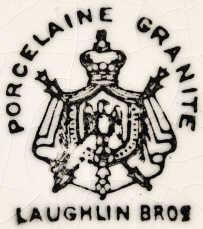 The Homer Laughlin China Company has marked their wares with a wide variety of backstamps. Shown to the right is an early Laughlin Brothers mark on a Cable shape sauceboat. Although the company started in the early 1870s, marks were not given any type of dating system until around 1912. This page focuses on the dated HLC markings used over the years. The Homer Laughlin China Company has marked their wares with a wide variety of backstamps. Shown to the right is an early Laughlin Brothers mark on a Cable shape sauceboat. Although the company started in the early 1870s, marks were not given any type of dating system until around 1912. This page focuses on the dated HLC markings used over the years.
The following breakdown originally appeared on pages 10-13 of An Overview of Homer Laughlin Dinnerware ©2002.
|
| 1911 - 1919 |
Marks with date codes from 1911 - 1919 will have:
- a number for the month (1 through 12)
- a single number for the year (1=1911, 2=1912,..., 8=1918, 9=1919)
- an "L" for the Laughlin potteries in East Liverpool, Ohio or an "N" for the Newell potteries in Newell, West Virignia.
|
|
The earliest dated mark I've found is from 1912, however, I wouldn't be surprised if a piece dated 1911 were to show up. Wares from this time period offer the least amount of confusion with respect to backstamps. It is the only decade that uses numbers for the months and single numbers for the years. The Genesee shape is the only HLC shape produced entirely within the 1911-1919 time frame, so if a piece of Genesee has a date code, it will be in the format shown below.
As you can see below, shape names were used in the backstamp. This practice was carried over from the previous decade where lines such as American Beauty, Colonial, Seneca, and others had their shape names written out in cursive. By 1917, the cursive style lettering was replaced by typeface.
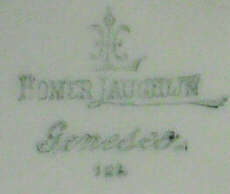
Jan. 1912 |
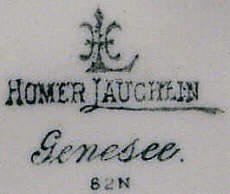
Aug. 1912 |
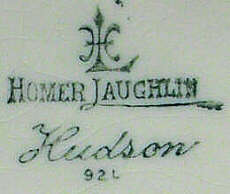
Sept. 1912 |
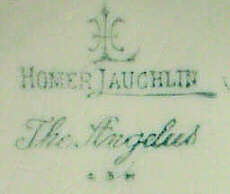
April 1913 |
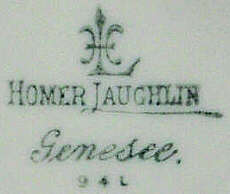
Sept. 1914 |
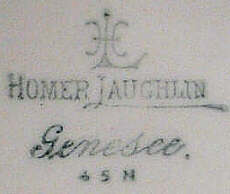
April 1915 |
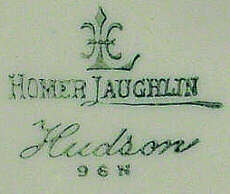
Sept. 1916 |
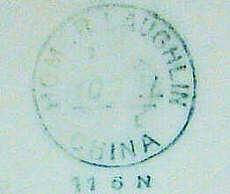
Nov. 1916 |
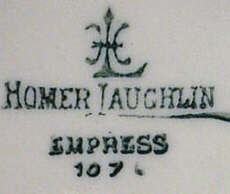
Oct. 1917 |
|
| 1920 and 1921 |
Marks from the early 1920s will have:
- a number for the month (1 through 12)
- a double digit number for the year (20=1920, 21=1921)
- an "L" for the Laughlin potteries in East Liverpool, Ohio or an "N" for the Newell potteries in Newell, West Virignia.
- in some cases, a 4 or 5 for the specific plant number in Newell. (6, 7, and 8 were not yet built at this time.)
|
|
For 1920 and 1921, the shape names were still used, as was a number for the month. However, the year changed from single digit to double. It is unfortunate this didn't continue for the rest of the 1920s, but for some reason, HLC reverted back to the single digit for the year in 1922. Even so, you may find a few examples from 1922 and 1923 with "22" or "23" in the backstamp, though these are not common.
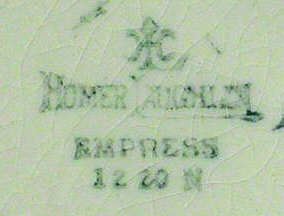
Dec. 1920 |
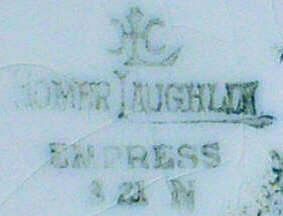
March 1921 |
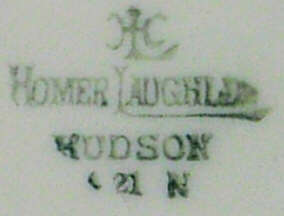
April 1921 |
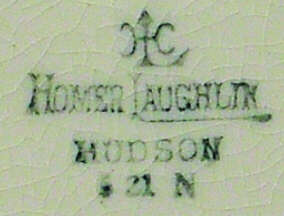
June 1921 |
|
| 1922 - 1929 |
Marks with date codes from the mid to late 1920s will have:
- Made in USA
- a single letter for the month (A=Jan, B=Feb, C=March, etc.)
- a single number for the year (2=1922, 3=1923,..., 7=1927, 8=1928, 9=1929)
- an "L" for the Laughlin potteries in East Liverpool, Ohio or an "N" for the Newell potteries in Newell, West Virignia.
- in some cases, a 4, 5, 6, 7, or 8 for the specific plant number in Newell.
|
|
For most of the 1920s, the markings are very similar to those from previous years. There are two major differences; a letter was used for the month, and "MADE IN USA" was put in place of the shape names.
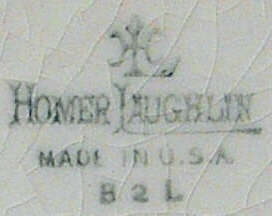
Feb. 1922 |
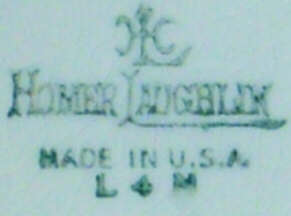
Dec. 1924 |
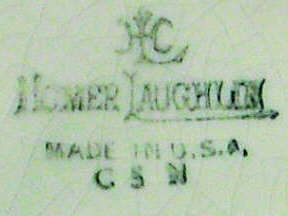
March 1925 |
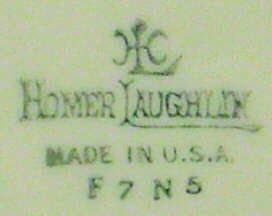
June 1927 |
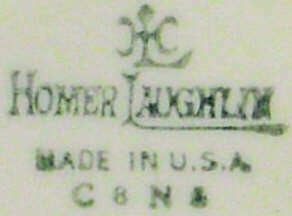
March 1928 |
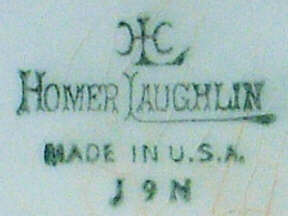
Oct. 1929 |
|
| 1930 |
Marks with a date code from 1930 will have:
- Made in USA
- a single letter for the month (A=Jan, B=Feb, C=March, etc.)
- a double digit for the year, 30=1930
- an "N" for the Newell potteries in Newell, West Virignia.
|
|
The 1930 backstamp is essentially a continuation of those from the 1920s, except a "30" is used instead of a single digit.
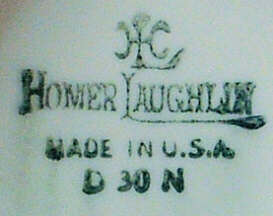
April 1930 |
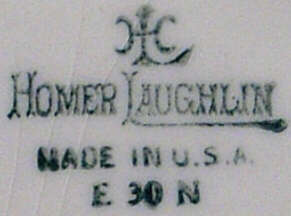
May 1930 |
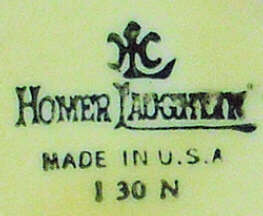
Sept. 1930 |
|
| 1931 and 1932 |
Marks with date codes from 1931 to late-1932 will have:
- Made in USA
- a single letter for the month (A=Jan, B=Feb, C=March, etc.)
- a single number for the year (1=1931, 2=1932)
- an "N" for the Newell potteries in Newell, West Virignia.
|
|
After 1930, HLC reverted yet again to a single number for the year. This was done for 1931 and most of 1932. A "21" was used for 1921 so it would be hard to confuse 1931 for 1921. However, the codes used for 1922 and 1932 are essentially the same. (The only difference is 1932 marks won't have an "L" as the plants in East Liverpool had been closed by this time.) The marks shown below come from Orleans - a shape we know was made only in the 1930s. Knowing the shapes makes dating easier. A "2" on a dated piece of Century has to be 1932 as the shape was first made in 1931.
The only shapes made in the early 1920s and the early 1930s are Empress, Republic, and Kwaker. If there is any doubt left, especially with these three shapes, then you may have to look at the decorative treatments and try to figure out the era to which it belongs.
|
| 1932 - 1968 |
Marks with date codes from mid-1932 to 1968 will have:
- Made in USA
- a single letter for the month (A=Jan, B=Feb, C=March, etc.)
- a double digit number for the year (32=1932, 33=1933,..., 64=1964, 65=1965, etc)
- an "N" for the Newell potteries in Newell, West Virignia
- a 4, 5, 6, 7, or 8 for the specific plant number.
|
|
Towards the end of 1932, HLC started using two digits for the year. This practice continued all the way through 1968. Many lines made during this time also included the shape name. Unfortunately, there were many lines from the 30s to the 60s that were marked, but lacked any type of date code. These include, but are not limited to; Coronet, Craftsman, OvenServe, Kitchen Kraft, (vintage) Fiesta®, Kraft Blue, Kraft Pink, Wells, Wells Art Glazes, Antique Orleans, most lines made for Quaker Oats, Colorama, Kenilworth, Serenade, and Triumph.
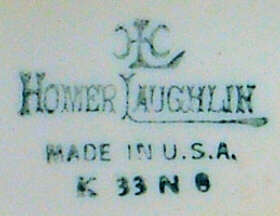
Oct. 1933 |
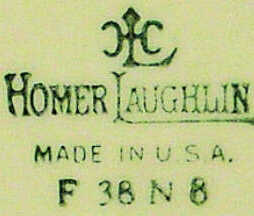
June 1938 |
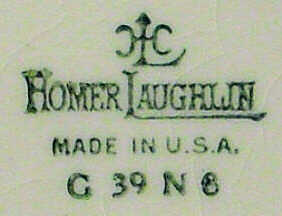
July 1939 |
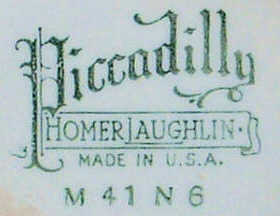
Dec. 1941 |
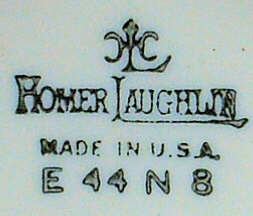
May 1944 |
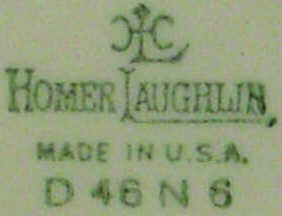
April 1946 |
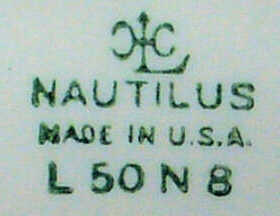
Nov. 1950 |
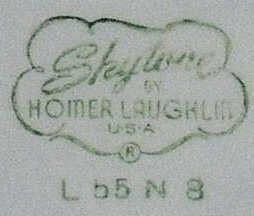
Nov. 1955 |
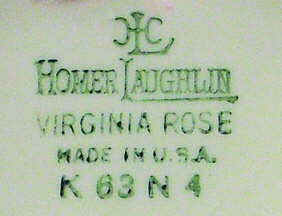
Oct. 1963 |
Notice the Piccadilly backstamp above has an "M" as the month -- the 13th letter of the alphabet. During the 1930s, the letter "I" wasn't always used and by the 1940s it disappears from all HLC markings.
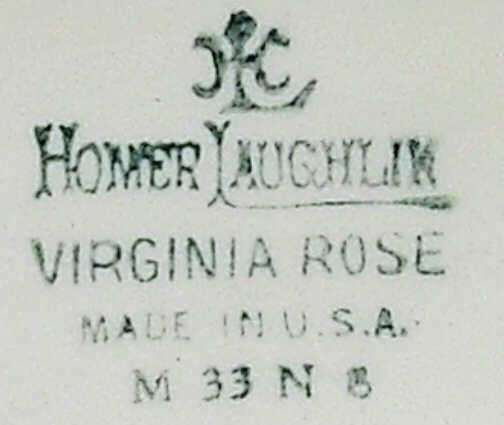
Letter "M" used in 1933 |
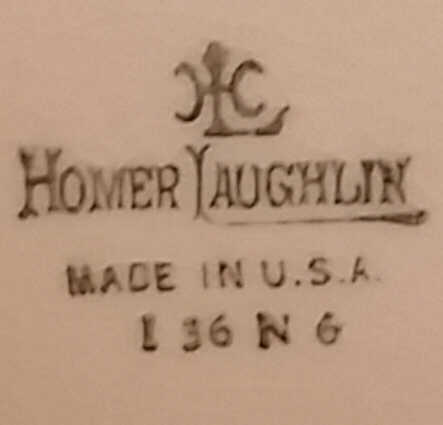
Letter "I" used in 1936 |
The following Virginia Rose backstamps from various years show the twelve letters (without the letter "I") used to designate each month of the year.
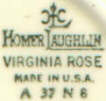
A: January |
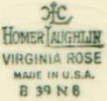
B: February |
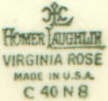
C: March |
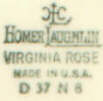
D: April |
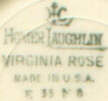
E: May |
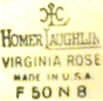
F: June |
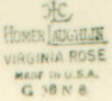
G: July |
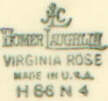
H: August |
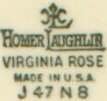
J: September |
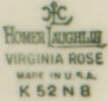
K: October |
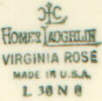
L: November |
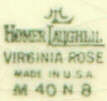
M: December |
|
| 1969 - 1980 |
Marks with date codes from the late 1960s to 1980 will have:
- Made in USA
- a standard four digit year, 1969, 1970,..., 1979, 1980
|
|
In 1969, HLC started using a standard four digit number for the year. There were no other numbers or letters for months or plants. By this time, it became standard practice to mark dinner plates. Other larger pieces such as chop plates and platters may or may not be marked. All other items from a shape were usually not marked at all. The four digit year mark lasted until the very early 1980s. Most reissue Harlequin dinner plates will have a mark like the one shown.
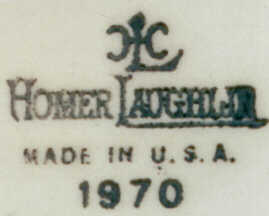
1970 |
|
| 1980s |
Marks with date codes from 1981 to the late 1980s will have:
- Made in USA
- a single letter for the month (A=Jan, B=Feb, C=March, etc.)
- a double digit number for the year , 81=1981, 82=1982, etc.
|
|
For the 1980s, a single letter was used to indicate the month and a two digit number for the year. This marking would last until the late 1980s. It was used mainly on the last remaining semi-vitreous wares such as Brittany and International.
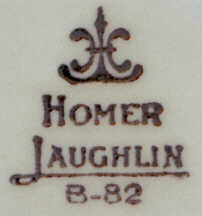
Feb. 1982 |
|
| Best China and beyond... |
|
HLC started to focus more on hotel and restaurant ware starting in 1960. They sold their vitrified ware under the name "Best China" for many years and developed a special date code for the backstamp. The first letter represents the year. A=1960. B=1961, and so on. Z=1985. When 1986 came around, two letters were used; AA. BB=1987, CC=1988,... ZZ=2011. In 2012, three letters had to be usd; AAA=2012, BBB=2013, etc. The next letter started out representing the month, but that later changed to either an A, B, C, or D to represent the 1st, 2nd, 3rd, and 4th quarters respectively.
You may notice some Roman numerals at the end of a date code. These represent a particular glazing line at the plant. They are not terribly relevant as the only significant information lies with the leading letter or letters for the year of manufacture. The dating system is still used by the pottery today, now known as The Fiesta® Tableware Company. A full table of letters with their corresponding years is given at the bottom of the page.
The "star" marking was first. It lasted for the first four or five years until it was replaced by the more familiar HLC logo marking.
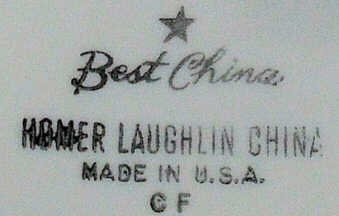
C = 1962 |

D = 1963 |
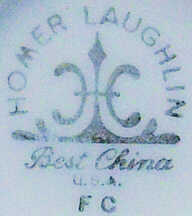
F = 1965 |
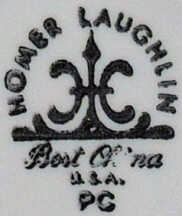
P = 1975 |
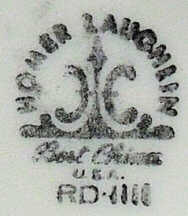
R = 1977 |
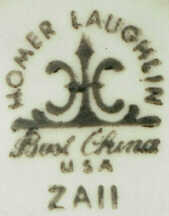
Z = 1985 |
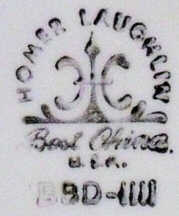
BB = 1987 |

EE = 1990 |
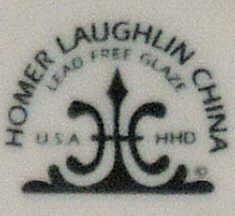
HH = 1993 |
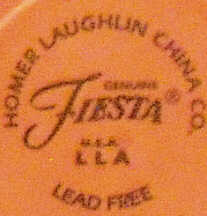
LL = 1997 |
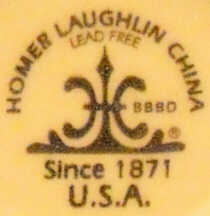
BBB = 2013 |
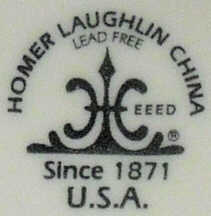
EEE = 2016 |
| A |
1960 |
|
|
|
AA |
1986 |
|
|
|
AAA |
2012 |
| B |
1961 |
|
|
|
BB |
1987 |
|
|
|
BBB |
2013 |
| C |
1962 |
|
|
|
CC |
1988 |
|
|
|
CCC |
2014 |
| D |
1963 |
|
|
|
DD |
1987 |
|
|
|
DDD |
2015 |
| E |
1964 |
|
|
|
EE |
1990 |
|
|
|
EEE |
2016 |
| F |
1965 |
|
|
|
FF |
1991 |
|
|
|
FFF |
2017 |
| G |
1966 |
|
|
|
GG |
1992 |
|
|
|
GGG |
2018 |
| H |
1967 |
|
|
|
HH |
1993 |
|
|
|
HHH |
2019 |
| I |
1968 |
|
|
|
II |
1994 |
|
|
|
III |
2020 |
| J |
1969 |
|
|
|
JJ |
1995 |
|
|
|
JJJ |
2021 |
| K |
1970 |
|
|
|
KK |
1996 |
|
|
|
|
|
| L |
1971 |
|
|
|
LL |
1997 |
|
|
|
|
|
| M |
1972 |
|
|
|
MM |
1998 |
|
|
|
|
|
| N |
1973 |
|
|
|
NN |
1999 |
|
|
|
|
|
| O |
1974 |
|
|
|
OO |
2000 |
|
|
|
|
|
| P |
1975 |
|
|
|
PP |
2001 |
|
|
|
|
|
| Q |
1976 |
|
|
|
QQ |
2002 |
|
|
|
|
|
| R |
1977 |
|
|
|
RR |
2003 |
|
|
|
|
|
| S |
1978 |
|
|
|
SS |
2004 |
|
|
|
|
|
| T |
1979 |
|
|
|
TT |
2005 |
|
|
|
|
|
| U |
1980 |
|
|
|
UU |
2006 |
|
|
|
|
|
| V |
1981 |
|
|
|
VV |
2007 |
|
|
|
|
|
| W |
1982 |
|
|
|
WW |
2008 |
|
|
|
|
|
| X |
1983 |
|
|
|
XX |
2009 |
|
|
|
|
|
| Y |
1984 |
|
|
|
YY |
2010 |
|
|
|
|
|
| Z |
1985 |
|
|
|
ZZ |
2011 |
|
|
|
|
|
|
|
|